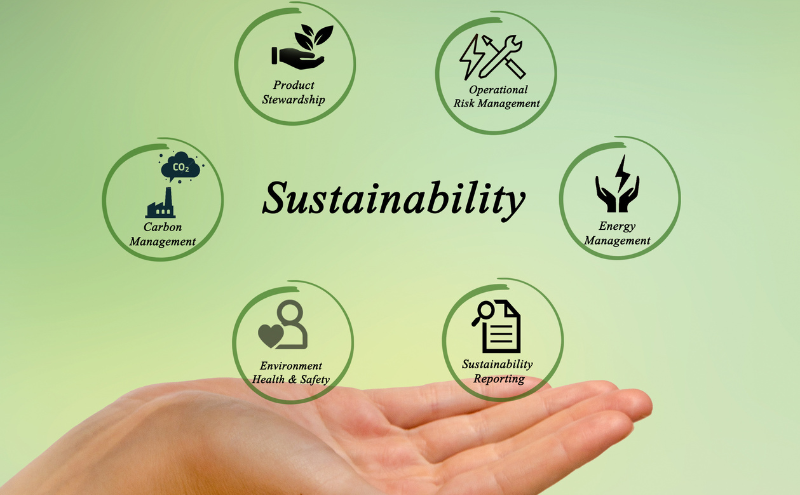
Understanding Sustainability and Its Significance
Sustainability encompasses a wide-ranging field that provides students and graduates with comprehensive insights into various aspects of the human world, spanning business, technology, environment, and social sciences. In today’s world, where reducing carbon emissions and advancing future technologies are paramount, the skills obtained through sustainability education are highly sought after. This interdisciplinary discipline draws from politics, economics, philosophy, social sciences, and hard sciences. Companies, particularly at the graduate level, prioritize sustainability skills and environmental awareness as they strive to comply with new regulations.
Sustainability stands as one of the latest academic subjects that aim to connect social sciences with civic engineering, environmental science, and future technologies. When we hear the term “sustainability,” renewable energy sources, carbon emission reduction, environmental protection, and maintaining the delicate balance of Earth’s ecosystems often come to mind. In essence, sustainability seeks to safeguard our natural environment, promote human and ecological well-being, foster innovation, and uphold our way of life. Due to the growing demand for sustainability expertise, a master’s degree is not always a prerequisite for most positions, as bachelor’s programs, and sometimes even lower levels of education, adequately prepare individuals for careers in sustainability. For more information on sustainability degrees and education, it is beneficial to explore the various options available.
The concept of sustainability revolves around studying the functioning of natural systems, the preservation of biodiversity, and the ability to sustain ecological balance. It also acknowledges that modern human civilization relies on resources to maintain our way of life (1). Countless examples throughout history demonstrate how civilizations have damaged their own environments and severely jeopardized their survival prospects (some of which are explored in Jared Diamond’s book, “Collapse: How Complex Societies Choose to Fail or Survive”) (10). Sustainability strives to establish harmonious coexistence with the natural world, safeguarding it from harm and destruction.
In our present-day, consumerist, and predominantly urban existence in developed nations, we consume substantial amounts of natural resources daily. Urban centers consume more energy compared to rural areas (2, p3-4), and they utilize a significant amount of power for street lighting, public infrastructure, household appliances, heating, and other essential requirements. However, sustainable living should not solely focus on urban dwellers; improvements can be made across all settings. It is estimated that we consume approximately 40% more resources each year than we can replenish, emphasizing the urgent need for change (3, p2). Sustainability and sustainable development aim to strike a delicate balance between competing demands: the drive for technological and economic progress and the imperative to protect our living environments. Sustainability extends beyond environmental considerations (4); it encompasses the health of our society, ensuring that no individuals or aspects of life suffer as a consequence of environmental policies. Furthermore, it involves contemplating the long-term consequences of human actions and exploring avenues for improvement (2).
The Three Pillars of Sustainability: A Comprehensive Approach
In 2005, the World Summit on Social Development identified three fundamental pillars that underpin the philosophy and social science of sustainable development. These pillars, widely recognized in national standards and certification schemes, form the foundation for addressing the critical challenges faced by the world today. The Brundtland Commission eloquently defined sustainable development as “development that meets the needs of the present without compromising the ability of future generations to meet their own needs” (6). Therefore, in our decision-making processes, we must consider the impact on the future as we navigate the present.
1. Economic Development
Economic development poses significant challenges as it often becomes entangled with differing political ideologies, disagreements on what is economically viable, and concerns about its effects on businesses, jobs, and employability (2, p4). It also involves incentivizing businesses and organizations to go beyond their legal obligations and adhere to sustainability guidelines. Additionally, encouraging individuals to contribute their part, even on a small scale, is essential. While the consumer-driven market demands significant resources for modern life (6), it is crucial to regain control over our consumption patterns in order to protect the environment. Economic development strives to provide people with what they need while preserving their quality of life, especially in developing nations, and reducing the financial burden and bureaucratic obstacles associated with sustainable practices.
2. Social Development
Social development encompasses various aspects. Foremost is the awareness of and legislative protection for public health against pollution and other harmful activities of businesses and organizations (6). In North America, Europe, and other developed regions, robust checks and legislative programs are in place to safeguard people’s health and well-being. Social development also involves ensuring access to essential resources without compromising the quality of life. Sustainable housing is currently a significant concern, focusing on constructing homes with sustainable materials. Education plays a vital role as well, encouraging active participation in environmental sustainability and providing knowledge about the effects of environmental protection, as well as highlighting the risks if we fail to achieve our goals (7, p7-12).
3. Environmental Protection
Preserving the environment requires collective action, and there are numerous ways individuals can contribute, such as recycling, reducing power consumption, opting for walking instead of driving short distances, and more. Businesses are regulated to prevent pollution and minimize carbon emissions. Incentives exist for installing renewable energy sources in homes and businesses. Environmental protection stands as the third pillar and, for many, represents the primary concern for the future of humanity. It encompasses the study and preservation of ecosystems, air quality, resource integrity, and sustainability while addressing factors that stress the environment (6). Additionally, it involves leveraging technology to drive a greener future, recognizing the importance of developing technology and biotechnology for sustainability while safeguarding the environment from potential harm associated with technological advancements (1).
Primary Goals of Sustainability
The sustainable development community operates on a global scale. In 2012, the United Nations Conference on Sustainable Development convened to establish a set of goals to strive for, building upon the achievements of the Millennium Development Goals (MDG) in reducing global poverty while acknowledging the remaining challenges. This resulted in the formulation of 17 Sustainable Development Goals (SDGs) (8), which include:
- Eradicating poverty and hunger
- Improving education and healthcare, particularly water quality and sanitation
- Achieving gender equality
- Promoting sustainable economic growth and job creation
- Addressing the impacts of climate change, pollution, and other environmental factors that harm people’s health, livelihoods, and lives
- Ensuring the health of land, air, and sea
Moreover, the concept of nature’s rights is recognized, emphasizing humanity’s stewardship of the world and the importance of placing people at the forefront of resolving global issues (9). This


